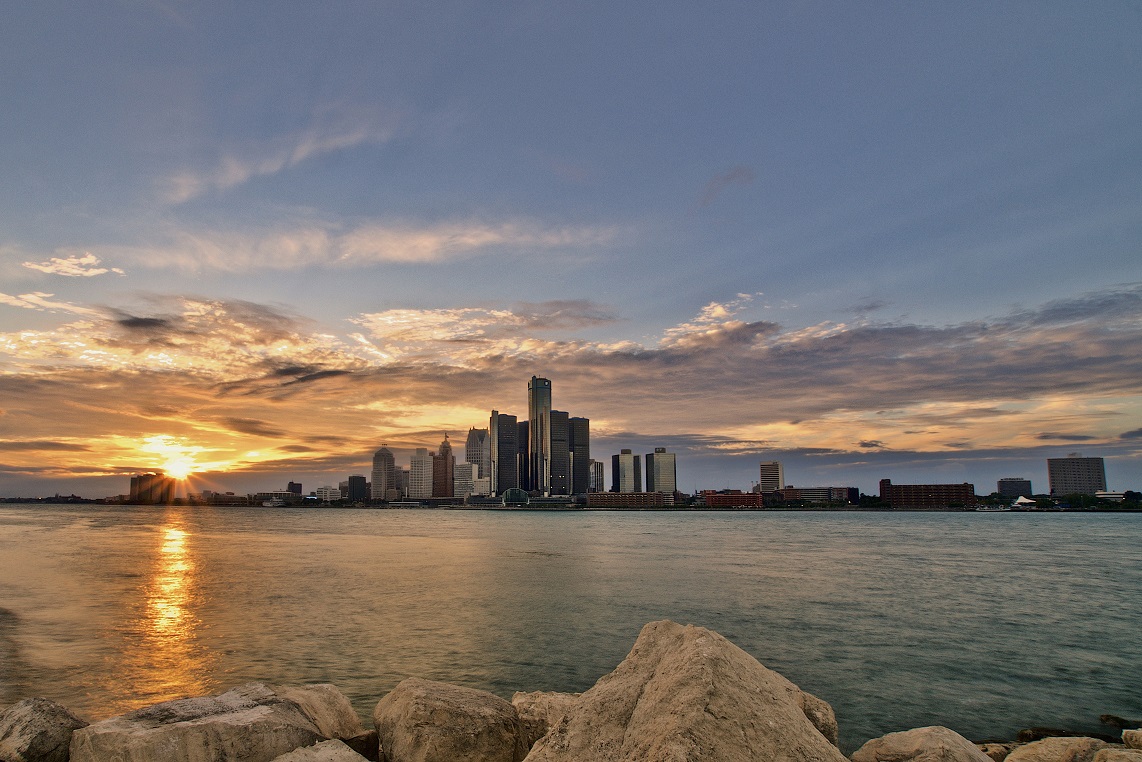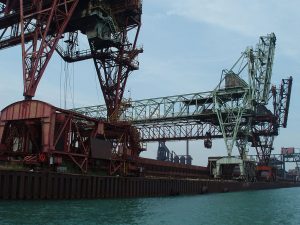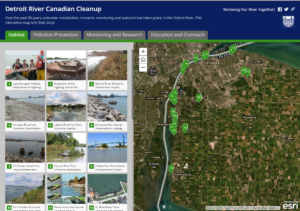

Sunset Fountains on the Detroit River Walk, courtesy of Scott Smithson via flickr.com
As the city of Detroit continues an economic and cultural renaissance from the depths of its well-publicized bankruptcy, its namesake river has been taking a similar path of recovery.
The popular narrative now is that the river that once was industry’s dumping ground is well into a restoration process.
“This ecological recovery is remarkable,” said John Hartig, the author of a 2018 report by the International Association of Great Lakes Research that chronicles the river’s renaissance. Hartig is on the board of the Detroit Riverfront Conservancy and helped create the Detroit River International Refuge.
Hartig cites habitat restoration and the return and health of wildlife to the river that he said was “one of the most polluted rivers in the United States” as evidence of recovery.
One of a long list

Shipping industry along the Detroit River, courtesy of NOAA
The Detroit River, like many waterways in the Great Lakes region, was the dumping ground for toxic pollutants in the heavy industrial era of the 1950s and 1960s.
The river was put on a 1987 list of officially designated Areas of Concern where, despite its nascent recovery, it remains today.
The U.S. Environmental Protection Agency estimates that there are still between three and four million cubic yards of toxic sediment in the river.
The agency’s best estimate for cleanup and removal from the list is 2025 or beyond. EPA has overall responsibility for cleanup of the river and its removal from the 1987 list.
Stark assessment
In spite of the river’s recovery and efforts to publicize it, staff from Michigan’s Department of Environment, Great Lakes, and Energy recently offered a stark assessment of the river.
“No area of the Detroit River is clean,” said Sam Noffek, an EGLE aquatic biologist who said the “entire Detroit River shoreline needs remediation.”
“We know that things aren’t better, even though they look a little bit better,” Melanie Foose, EGLE’s Detroit River cleanup coordinator, said after examining sediment in the river.
Noffek and Foose’s comments were made to a group of environmentalists and concerned citizens in Windsor, Ontario, according to reporting by the Windsor Star.
In emails and a phone interview with Great Lakes Now, Foose expanded on her statements in Windsor and provided additional context.
Foose referenced the tension between what she referred to as the “remarkable recovery” of the Detroit River that has taken place and the work that remains to return it to an “unimpaired” status.
“The continuing story of the Detroit River’s recovery is very complicated, but it is indeed a story of remediation, recovery and revitalization,” according to Foose.
Foose cited the multiple partnerships with federal and state agencies along with local advocacy groups as a key to success.
“The story of partnerships is the very reason we have made this progress in the sediment knowledge of the river,” Foose said.
Healthy habitat, toxic sediment work remains
In what the U.S. EPA described as “significant progress,” the agency with its partners has identified, funded and implemented 13 habitat restoration projects in the Detroit River. They range from creating lake sturgeon spawning habitat, restoring wetland habitat and generally improving fish habitat in the river, according to spokesperson Rhiannon Dee.
The implemented projects represent most of the work needed to remove habitat from the 1987 list of impairments of the river, Dee said.
And cleaning out those millions of cubic yards of sediment remains heavy work.
It is “costly and time-consuming,” and even the process of “identifying willing project partners can take a significant amount of time,” according to Dee.
That’s driving the 2025-or-beyond date for dealing with the sediment, which would be 38 years after the river was put on the Area of Concern list and 15 years after federal Great Lakes restoration money became available in 2010.
If there’s good news on the toxic sediment front, it’s that a 1.5 acre site near Belle Isle may be nearing a fix. The site is contaminated with heavy metals and PAHs and is being evaluated to be capped instead of having the sediment removed.
PAHs are toxic chemicals to aquatic species and are listed as pollutants of concern by the EPA.
“Capping has proven to be an effective and economically viable method for addressing contaminated sediments throughout the Great Lakes and nationwide. Physically removing all contaminated sediment in Areas of Concern is simply not economically feasible,” Dee said.
Contaminated sites that are capped require long-term monitoring and funding to insure the integrity of the cap over time, according to the EPA.
Complacency warning
Hartig takes the long-term view of the Detroit River’s recovery and the work that remains to be done.
“It clearly must be recognized that more needs to be done to fully realize the long-term goals of restoring the physical, chemical and biological integrity of the Detroit River and western Lake Erie,” Hartig said.
He sounded a cautionary note on complacency.
“As a scientist I am worried about societal complacency and the Detroit River reaching another negative tipping point if progress stalls,” he said. “But I believe that the progress achieved to date and the broad-based support for a healthy Detroit River bodes well for its future.”
EGLE’s Foose had a similar optimistic view, even with the hardest part of the restoration—toxic sediment removal—remaining.
“I expect a continuation of the remarkable recovery with the best work still to come,” Foose said.
John Hartig writes a monthly column, Great Lakes Moment, for Great Lakes Now.
Featured Image: Detroit River at Sunset, Photo by Peter Mol via pixabay.com cc0 1.0





